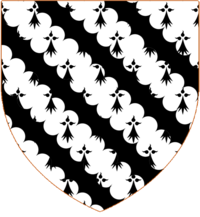Cyril Radcliffe, 1st Viscount Radcliffe
Lord of Appeal in Ordinary | |
|---|---|
| In office 1949–1964 | |
| Personal details | |
| Born | Cyril John Radcliffe 30 March 1899 Llanychan, Denbighshire, Wales |
| Died | 1 April 1977 (aged 78) Stratford-upon-Avon, Warwickshire, England |
| Nationality | British |
| Spouse |
Antonia Mary Roby Benson
(m. 1939) |
| Alma mater | University of Oxford |
Cyril John Radcliffe, 1st Viscount Radcliffe,
Background, education and early career
Radcliffe was born in Llanychan, Denbighshire, Wales, the son of an army captain. His maternal grandfather was President of the Law Society between 1890 and 1891.
Radcliffe was educated at
He was
During World War II, Radcliffe joined the
Indian Boundary Committees
Radcliffe, a man who had never been east of Paris,[1] was given the chairmanship of the two boundary committees set up with the passing of the Indian Independence Act. Radcliffe was given the task of drawing the borders for the new nations of Pakistan and India in a way that would leave as many Sikhs and Hindus in India and Muslims in Pakistan as possible. He was given only 5 weeks to complete the job.[2] Radcliffe submitted his partition map on 9 August 1947, which split apart Punjab and Bengal almost in half. The new boundaries were formally announced on 17 August 1947 – three days after Pakistan's independence and two days after India became independent of the United Kingdom.[3]
Radcliffe's efforts saw some 14 million people – roughly seven million from each side – flee across the border when they discovered the new boundaries left them in the "wrong" country. In the violence that ensued after independence, estimates of loss of life accompanying or preceding the partition vary between several hundred thousand and two million,
Speaking of his experience as the chairman of boundary committees, he later said-
"I had no alternative, the time at my disposal was so short that I could not do a better job. Given the same period I would do the same thing. However, if I had two to three years, I might have improved on what I did."[2]
The poet W. H. Auden referred to Radcliffe's role in the partition of India and Pakistan in his 1966 poem "Partition".[5]
Later career
In 1949, Radcliffe was made a
From 1957 he was chairman of the Radcliffe Committee, called to enquire into the working of the monetary and credit system. The committee published a report known as the
In 1962 he was made a hereditary peer as Viscount Radcliffe, of Hampton Lucy in the County of Warwick.[8]
Personal life
This section needs additional citations for verification. (January 2023) |
Lord Radcliffe married Antonia Mary Roby, daughter of Godfrey Benson, 1st Baron Charnwood and former wife of John Tennant, in 1939. He died in April 1977, aged 78. He had no issue and the viscountcy of Radcliffe became extinct on his death.
In 2006, two sets of Chancery barristers' chambers in Lincoln's Inn merged and adopted the name "Radcliffe Chambers".[9]
Arms
  |
|
See also
Notes
References
- ^ Partition: The Day India Burned (Television production). BBC. 14 August 2007. Archived from the original on 22 December 2021.
- ^ a b Know Your Constitution Quiz - EP 05, archived from the original on 22 December 2021, retrieved 18 February 2021
- ^ Pillallamari, Akhilesh (19 August 2017). "70 Years of the Radcliffe Line: Understanding the Story of Indian Partition". The Diplomat. The Diplomat. Retrieved 21 January 2021.
- ^ ISBN 978-0-521-85661-4
- ^ Auden, W. H. (1976). Collected Poems. p. 604.
- ^ "No. 38627". The London Gazette. 3 June 1949. p. 2748.
- ^ "Romanes Lectures since 1892". University of Oxford. Retrieved 11 January 2014.
- ^ "No. 42729". The London Gazette. 13 July 1962. p. 5563.
- ^ "History of Chambers l Radcliffe Chambers". Archived from the original on 6 March 2016. Retrieved 5 March 2016.
- ^ "Radcliffe, Viscount (UK, 1962 – 1977)". www.cracroftspeerage.co.uk.
Further reading
- Chester, Lucy P. Borders and Conflict in South Asia: The Radcliffe Boundary Commission and the Partition of Punjab. Manchester UP, 2009.
